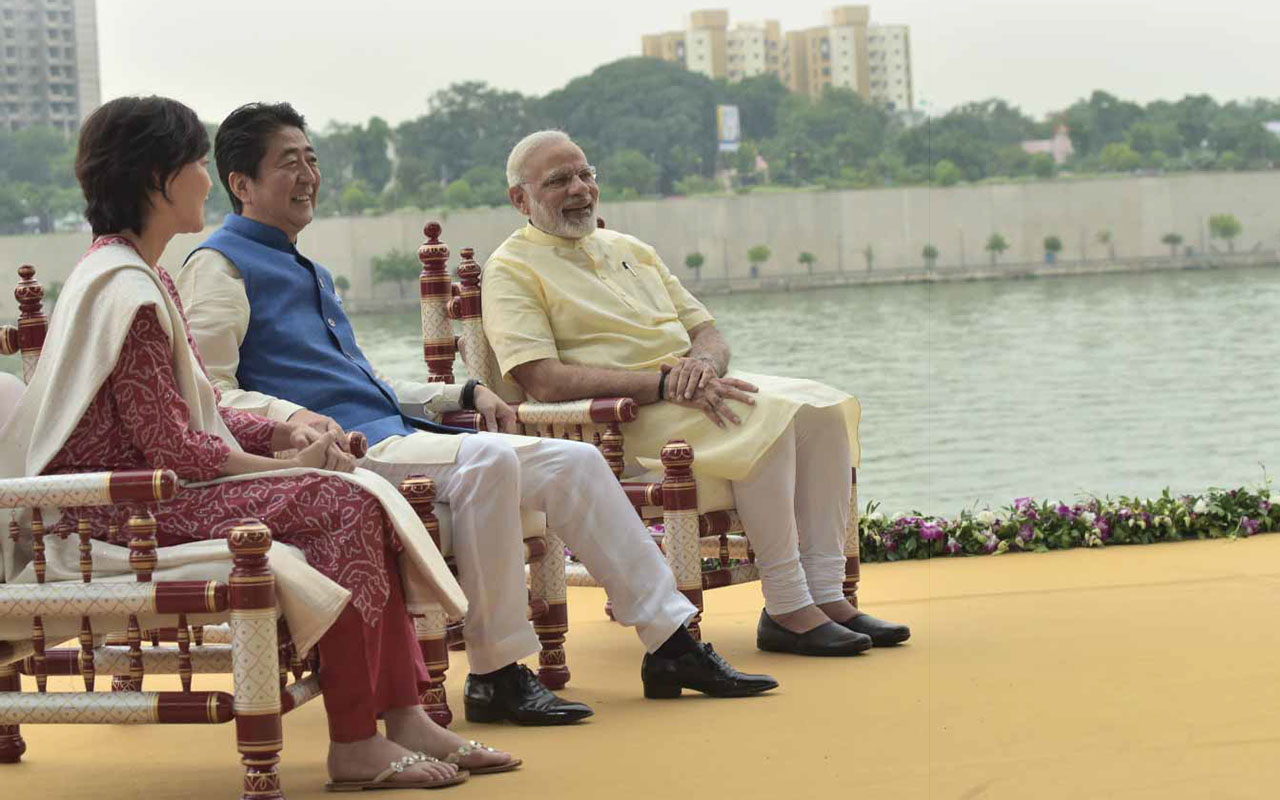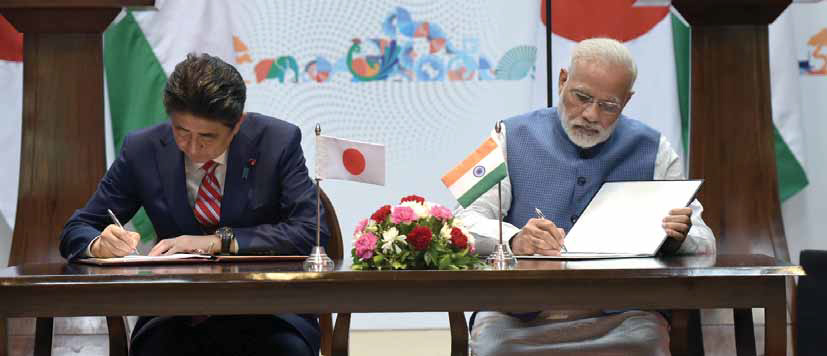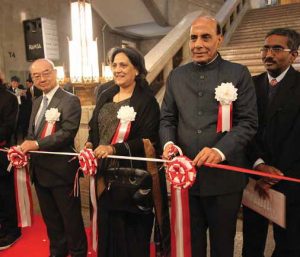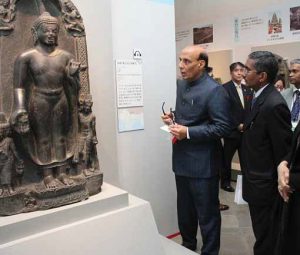
India-Japan share a long history of cordial relationship. The bilateral ties can be traced back to the period when Gautam Budhha preached his ideas of Buddhism. Japanese were quick to absorb these spiritual ideas and executed the same in their day to day life.
In short, spirituality and religion were the bricks on which the relations were assembled. At the end of Second World War, Japan was largely devastated and it took many years for it to recover from the vast-scale destruction. Since then, Japan has become an epitome for other nations who wish to evolve at a lively pace.
Today, Japan is an active player in world politics, and its investments & technology have spread across the globe. It
is always in India’s interest to maintain and strengthen close partnership with Japan.
The recent visit of Japanese Prime Minister Shinzo Abe to India on the sidelines of the 12th Summit on India-Japan Dialogue has reflected a matured and deep partnership between India and Japan. Several agreements were also inked including an agreement on ‘Bullet Train’ that is scheduled to run on Mumbai- Ahmadabad route.
In the last couple of years, the relations have seen growth and advancement in almost all areas. On the economic front, the complementarities between the two countries are particularly striking.
(i) Japan’s ageing population (23% above 65 years) and India’s youthful dynamism (over 50% below 25 years);
(ii) India’s rich natural and human resources and Japan’s advanced technology;
(iii) India’s prowess in services and Japan’s excellence in manufacturing;
(iv) Japan’s surplus capital for investments and India’s large and growing markets and the middle class.
Economic relations between India and Japan have huge potential for growth, given the obvious interrelations which exist between the two Asian economies. Japan’s interest in India is increasing due to a variety of reasons including India’s huge and growing market and its resources, especially the human resources.
The signing of the historic India-Japan Comprehensive Economic Partnership Agreement (CEPA) and its implementation from August 2011 is expected to further accelerate growth of trade, economic and commercial relations between the two countries.
Japanese Official Development Assistance (ODA), for long has been the backbone of the bilateral relationship, and still continues to provide long-term loans to India for its infrastructure development.
New Delhi’s metro network has been realized with the Japanese assistance. The Western Dedicated Freight Corridor (DFC), the Delhi-Mumbai Industrial Corridor with eight new industrial townships, the Chennai-Bengaluru Industrial Corridor (CBIC) are all mega projects on the anvil which will transform India in the next
decade.

Japan is the largest bilateral donor to India. Japanese ODA supports India’s efforts for accelerated economic development particularly in priority areas like power, transportation, environmental projects and projects related to basic human needs.
The Science & Technology Cooperation Agreement between India and Japan was signed on 29 November, 1985 with Ministry of Foreign Affairs Japan and Department of Science & Technology, India as nodal agencies on behalf of the two governments.
The cooperation picked up its momentum after establishment of India-Japan Science Council (IJSC) in the year 1993 and so far 17 annual meetings of IJSC have taken place. The IJSC activities include collaborative research projects sessions, academic seminars, and exploratory visits by scientists from both countries and Raman-Mizushima lecture series.
Under the collaborative projects, 6 priority themes for research in the basic sciences were identified. Another important cooperation under the new science and technology initiative between JST and DST is a theme based activity. The initial theme was information and communication technologies (ICT) under which several projects
were supported during 2006-2012. The current theme for JST-DST collaboration is on biomedical research. Under the S&T cooperative agreement between the two countries, MEXT and DST have signed Implementation Arrangement on 25 January, 2014 during the visit of Prime Minister Shinzo Abe to India.
Similarly, during the visit of Prime Minister of India to Japan, a year-long Festival of India in Japan 2014-15 was announced. The dance festival organized in October included more than 20 performances in 20 cities across Japan by Bharatanataym, Manipuri, Kudiyattam and Mohiniyattam dance groups from India. As a part of the festival, Hon’ble Home Minister Shri Rajnath Singh, along with the Japan’s State Minister for Internal Affairs & Communication, Mr. Kosaburo Nishime inaugurated the Exhibition of Buddhist Art at the prestigious Tokyo
National Museum on 16 March, 2015.

Affairs of India with H.E. Mrs. Deepa Gopalan Wadhwa, Ambassador of India to Japan at the Tape Cutting Ceremony of Exhibition on Indian
Buddhis
Other programmes under the festival included a Symposium on Buddhist Manuscripts, Food Festival and India- Japan Literary Festival. The arrival of Indians in Japan for business and commercial interests began in the 1870s at the two major open ports of Yokohama and Kobe. More Indians entered Japan during World War I when Japanese products were sought to fill gaps in demand that war-torn Europe could not meet. Following the great Kanto Earthquake in 1923, most of the Indians in Yokohama relocated to the Kansai region (Osaka-Kobe) and the city hosted the largest migrant Indian population in Japan.
Yokohama authorities offered special incentives to the Indian community after World War II to revive their old base in Kanto. The old Indian community in Japan focused on trading in textiles, commodities and electronics. With close linkages to India as well as connections in Hong Kong and Shanghai, they became major players in trading activities across Asia. A newer segment of the community is engaged in gems and jewellery. The Indian community established the Indian Merchants Association in Yokohama (IMAY) in 1929.

In recent years, there has been a change in the composition of the Indian community with the arrival of a large number of professionals. These include IT professionals and engineers working for Indian and Japanese firms as well as professionals in management, finance, education, and S&T research who are engaged with multinational as well as Indian and Japanese organizations. The Nishikasai area in Tokyo is emerging as a ‘mini-India’. The community is engaged in a range of cultural and social activities. This maintains their links with the motherland and also promotes contacts with their Japanese neighbours.
Their growing numbers had prompted the opening of two Indian schools in Tokyo and Yokohama. The community is actively engaged in events organized by the Embassy. The Indian community lives harmoniously with its neighbours and has developed relations with local governments to become valuable members of the Japanese community.From the above mentioned details, it is quite clear that relations between the two countries are constantly improving and growing. The days ahead should only be more eventful.
By Dr. Shekhar B. Ashtikar









